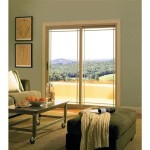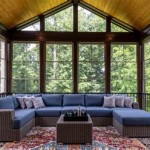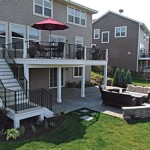The Enduring Appeal of the Covered Backyard Patio
The covered backyard patio represents a valuable addition to a residential property, offering a versatile outdoor living space that extends the functionality of the home. Unlike open patios, covered patios provide protection from the elements, enabling year-round enjoyment regardless of prevailing weather conditions. This feature enhances the overall livability and value of a property, making it an attractive investment for homeowners.
The design and construction of a covered backyard patio involve numerous considerations, ranging from material selection and structural integrity to aesthetic integration with the existing architecture and landscape. Careful planning and execution are essential to ensure the patio meets the homeowner's needs and preferences while adhering to local building codes and regulations. The following sections delve into various aspects of covered patio design, construction, and usage.
Protection from the Elements and Extended Seasonal Use
One of the primary benefits of a covered backyard patio is its ability to shield occupants from sun, rain, and snow. Direct sunlight can be intense, making outdoor activities uncomfortable and potentially harmful to the skin. A solid roof structure effectively blocks UV rays, creating a shaded area that is more pleasant and safer for relaxation and recreation. Similarly, rain and snow can render an open patio unusable, whereas a covered patio allows individuals to continue enjoying the outdoor space even during inclement weather.
The type of roofing material used in constructing the patio cover plays a crucial role in its effectiveness. Options include traditional shingles, metal roofing, polycarbonate panels, and even retractable awnings. Each material offers different levels of protection, durability, and aesthetic appeal. Shingles, for example, provide excellent insulation and blend seamlessly with the existing roof of the house. Metal roofing is known for its longevity and resistance to fire, while polycarbonate panels offer a translucent option that allows natural light to filter through while blocking harmful UV rays. Retractable awnings provide flexibility, allowing the patio to be exposed to the sun or shaded as desired.
Furthermore, the orientation of the patio in relation to the sun's path can influence its effectiveness. A patio facing south or west will receive the most direct sunlight, requiring a more robust roofing structure to provide adequate shade. Conversely, a patio facing north or east may require less extensive coverage, as it will naturally receive less intense solar radiation. Consulting with a landscape architect or contractor can help determine the optimal placement and orientation of the patio to maximize its usability and comfort.
Beyond the roof itself, additional features can further enhance the protection offered by a covered patio. Screens can be installed to keep out insects, creating a more comfortable environment for outdoor dining and relaxation. Curtains or drapes can provide additional shade and privacy, while space heaters or outdoor fireplaces can extend the use of the patio into the cooler months. These enhancements transform the covered patio into a truly versatile outdoor living space that can be enjoyed year-round.
The extended seasonal use of a covered patio translates to a greater return on investment for the homeowner. Instead of being limited to only enjoying the outdoor space during the warmer months, the covered patio provides a comfortable and protected area for relaxation, entertainment, and dining throughout the year. This expanded functionality enhances the overall livability of the property and makes it a more attractive asset.
Design Considerations and Integration with Existing Architecture
The design of a covered backyard patio should complement the existing architecture of the house and blend seamlessly with the surrounding landscape. A well-designed patio will appear as a natural extension of the home, enhancing its aesthetic appeal and increasing its value. Key considerations include the style of the house, the materials used in its construction, and the overall layout of the backyard.
The style of the house will dictate the overall aesthetic of the patio. For example, a traditional-style home may benefit from a covered patio with classic architectural details, such as columns, arches, and decorative trim. A modern-style home, on the other hand, may be better suited for a minimalist patio design with clean lines and geometric shapes. The materials used in the construction of the patio should also be consistent with the materials used in the construction of the house. This creates a cohesive and harmonious look that enhances the overall aesthetic appeal of the property.
The size and shape of the patio should be proportionate to the size and shape of the backyard. A large patio in a small backyard can overwhelm the space, while a small patio in a large backyard may appear insignificant. The shape of the patio should also be carefully considered. A rectangular patio may be suitable for a formal backyard, while a curved or irregularly shaped patio may be more appropriate for a naturalistic landscape.
The placement of the patio should also be carefully considered. Ideally, the patio should be located in an area that receives ample sunlight but is also shaded from the hottest afternoon sun. The patio should also be easily accessible from the house, ideally through a sliding glass door or French doors. This makes it easy to transition between the indoor and outdoor spaces. The patio should also be positioned to take advantage of any existing views, such as a garden, a pool, or a scenic vista.
The integration of the patio with the surrounding landscape is also crucial. The patio should be surrounded by plants, shrubs, and trees that complement its design and provide shade and privacy. A well-landscaped patio will feel like a natural extension of the backyard, creating a relaxing and inviting outdoor living space. Consider incorporating features such as outdoor lighting, water features, and fire pits to further enhance the ambiance of the patio.
The materials used in the construction of the patio should be durable, weather-resistant, and aesthetically pleasing. Common materials include wood, composite decking, concrete pavers, and natural stone. Wood is a popular choice for its natural beauty and warmth, but it requires regular maintenance to prevent rot and decay. Composite decking is a low-maintenance alternative to wood that is resistant to rot, insects, and fading. Concrete pavers are a versatile and affordable option that can be arranged in a variety of patterns and colors. Natural stone is a durable and elegant choice that adds a touch of sophistication to the patio.
Enhancement of Property Value and Outdoor Living Space
A well-designed and constructed covered backyard patio significantly enhances the overall value of a residential property. It expands the living space of the home, providing an additional area for relaxation, entertainment, and dining. This increased functionality makes the property more attractive to potential buyers, ultimately increasing its market value.
The enhanced outdoor living space offered by a covered patio is particularly appealing to families with children and individuals who enjoy entertaining guests. The patio provides a safe and comfortable area for children to play, while also offering a relaxing space for adults to socialize and unwind. The covered structure protects occupants from the elements, allowing them to enjoy the outdoor space regardless of the weather conditions.
A covered patio can also serve as an outdoor dining area, providing a unique and enjoyable setting for meals. The patio can be furnished with a dining table, chairs, and a grill, creating a fully functional outdoor kitchen. This allows homeowners to prepare and enjoy meals outdoors, taking advantage of the fresh air and natural surroundings. Outdoor lighting can further enhance the dining experience, creating a warm and inviting ambiance.
The versatility of a covered patio makes it a valuable asset for homeowners. It can be used for a variety of purposes, from relaxing and reading a book to hosting parties and family gatherings. The patio can also be used as an outdoor office, providing a quiet and secluded space to work from home. The possibilities are virtually endless, making the covered patio a truly multifunctional space.
The addition of a covered patio can also lead to energy savings. The roof structure helps to shade the interior of the house, reducing the amount of sunlight that enters through the windows. This can lower cooling costs during the summer months, resulting in significant energy savings. The patio also provides a natural buffer zone between the interior and exterior of the house, helping to insulate the home and reduce heating costs during the winter months.
In conclusion, the covered backyard patio represents a valuable investment that enhances the livability, functionality, and value of a residential property. Its ability to provide protection from the elements, seamlessly integrate with existing architecture, and expand the outdoor living space makes it an attractive addition for homeowners seeking to maximize their enjoyment of their property.

20 Best Patio Cover Ideas Covered Designs

9 Best Backyard Patio Ideas For Inspirations Deepnot Covered Patios

Stunning Outdoor Patio Cover And Pergolas Gallery Inspire Your Space

310 Best Outdoor Covered Patios Ideas In 2024 Backyard Patio

23 Patio Cover Ideas That Make Outdoor Living A Breeze Architectural Digest

50 Best Patio Design Ideas For Outdoor And Backyard In 2024 Foyr

Attached Patio Cover In Katy

Patio Covers Houston Dallas Tcp Custom Outdoor Living

Dallas Outdoor Design What S Better Pergolas Or Covered Patios

Beautiful Patios Archives Custom








